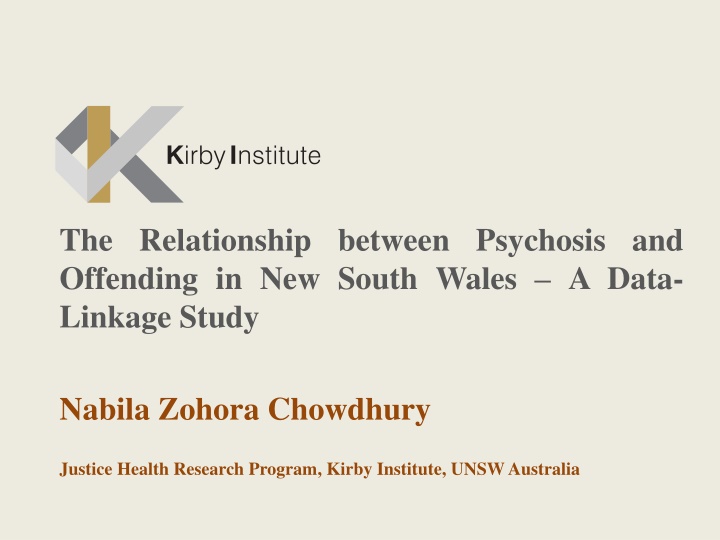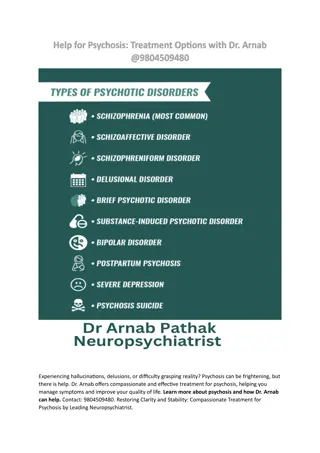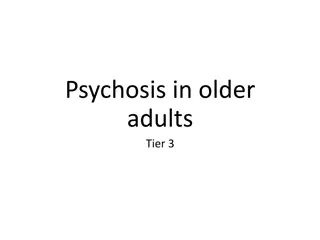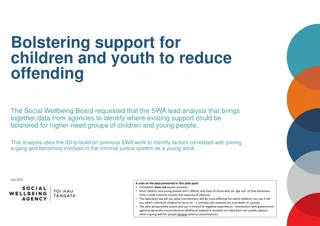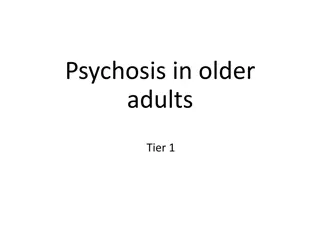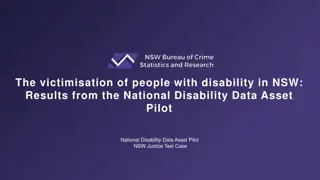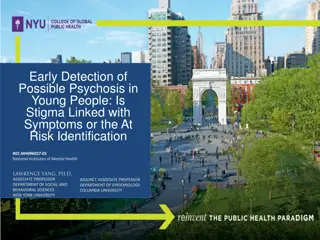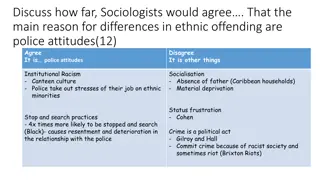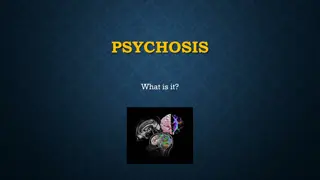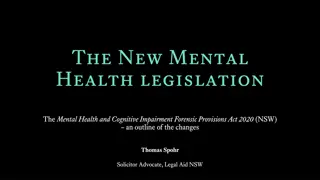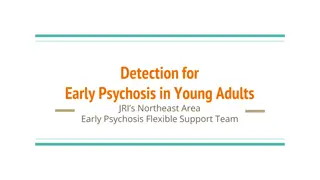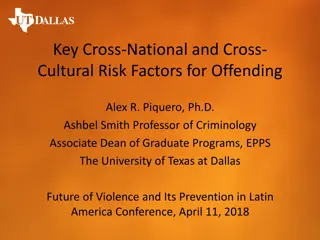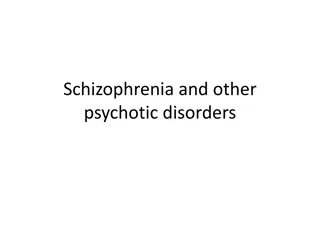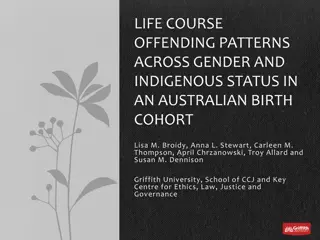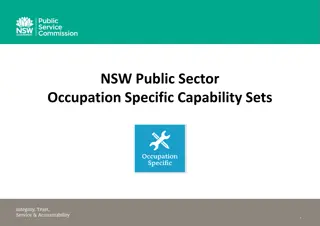Relationship between Psychosis and Offending in NSW
Psychosis, a common feature of mental illness, can lead to criminal offending, particularly violent crimes. Studies have shown an increased risk of violence in individuals with psychosis, presenting challenges for public health and criminal justice systems. This data linkage study in New South Wales aims to explore the connection between psychosis and offending behavior to inform better intervention strategies and support for affected individuals.
Download Presentation

Please find below an Image/Link to download the presentation.
The content on the website is provided AS IS for your information and personal use only. It may not be sold, licensed, or shared on other websites without obtaining consent from the author.If you encounter any issues during the download, it is possible that the publisher has removed the file from their server.
You are allowed to download the files provided on this website for personal or commercial use, subject to the condition that they are used lawfully. All files are the property of their respective owners.
The content on the website is provided AS IS for your information and personal use only. It may not be sold, licensed, or shared on other websites without obtaining consent from the author.
E N D
Presentation Transcript
The Relationship between Psychosis and Offending in New South Wales A Data- Linkage Study Nabila Zohora Chowdhury Justice Health Research Program, Kirby Institute, UNSWAustralia
Investigators Professor Tony Butler-Kirby Institute Dr Stephen Allnutt-JH&FMHN A/Professor Peter Schofield Hunter New England Health A/Professor Handan Wand - Kirby Institute Dr Armita Adily Kirby Institute Dr Azar Kariminia Kirby Institute Professor John Kaldor Kirby Institute Mr Luke Grant- Corrective Services NSW A/Professor Don Weatherburn - BOCSAR Mr Olayan Albalawi PhD Scholar, Kirby Institute
Presentation Background Data Linkage Process Definitions Preliminary Findings Future Directions
Background Psychosis is a feature of mental illness typically characterized by radical changes in personality, impaired functioning, and a distorted or non-existent sense of objective reality The most common psychotic disorder is schizophrenia affecting about 21 million people worldwide Each year, approximately one in every five Australians will experience a mental illness 1 in 100 people have or will develop schizophrenia during their lifetime
Background Around 12,000 hospitalisations occur for psychosis in NSW each year Annual cost of treatment of psychosis in Australia is estimated at $79,537 per person Psychosis is considered to be a risk factor for criminal offending, particularly violent offending
Background A meta-analysis of 204 studies (Douglas, 2009) showed that psychosis was associated with a 49% to 68% increase in the odds of a conviction for violence, compared with the odds of violence in the absence of psychosis A Swedish population based data-linkage study (Fazel, 2006) investigated the impact of psychotic disorders on violent crime over a 13 year period estimated that patients with severe mental illness commit one in 20 violent crimes
Background Western Australian study (Morgan, 2013) examined the prevalence, type and pattern of offending in those born between 1955 and 1969 and diagnosed with any psychiatric illness between 1985 and 1996 and found that 20% of those convicted of violence had been diagnosed with a mental illness Victorian study (Wallace, 2004) found that 21% of individuals with schizophrenia had been convicted of a criminal offence compared with 8% of controls over a 25-year period (1975-2000) NSW study (Butler & Allnutt, 2003) found that prevalence of psychosis in NSW inmates was thirty times higher than in the Australian community
Background No population based study investigating the relationship between psychosis and offending in New South Wales
Primary Objectives Determine the association between psychosis and subsequent offending behaviour Determine the population level impact of psychosis on offending behaviour Determine the proportion of those diagnosed with psychosis for the first time in prison
Secondary Objectives Examine the rates of re-offending among those diverted into mental treatment by the NSW Court Liaison Service Compare the experiences of the offenders with and without psychosis while they are in prison Find out what happens to people with psychosis who also received treatment for opiate dependence by Linkage of the PHDAS data with cases Examining the rate and causes of post-release mortality in offenders with and without psychosis
Definitions Psychosis cases: All individuals diagnosed with psychosis on admission for a hospital episode or on presentation to an emergency department Admitted Patients data - 1 July 2001 31 December 2012 Emergency Patients data - 1 Jan 2005 31 December 2012 Controls: For each case, two controls without any record of a diagnosis of psychosis from several datasets matched by birth year and sex Offence: All individuals who have committed at least one offence from the Re-offending dataset (ROD) between 1 July 2001 to 31 December 2012
Cases (People diagnosed with psychosis) Based on International Classification of Diseases, we have grouped cases into the following categories: 1. Schizophrenia and Delusional Disorder 2. Mood Affective Disorders 3. Psychotic Disorder due to psychoactive substance use 4. Other psychosis
Data Linkage Process CASES (Psychosis) 90,036 Individuals & 343,882 Records NSW Emergency Department Data Collection 1,151,295 Individuals & 6,349,233 Records NSW Admitted Patients Data Collection 1,251,277 Individuals & 8,913,496 Records
Data Linkage Process Linkage By CHeReL Reoffending Database (ROD) 493,042 Individuals & 1,113,481 Records Mental Health Ambulatory Data 292,763 Individuals & 29,022,252 Records CASES (Psychosis) 90,036 Individuals & 343,882 Records Offender Integrated Management System & Pharmaceutical Drugs of Addiction Systems NSW Births, Deaths, Marriages
Approvals Timeline Protocol Preparation and Submission Data Quality Assurance MAY 2016 PRESENT MAY 2014 - NOV 2014 DEC 2014 AUG 2015 SEP 2015 APR 2016 Ethics Approval by Ethics Committee Started Receiving Data 15
Preliminary Results Total psychosis cases 90,036 Total psychosis records 343,882 57% Men 6% Indigenous
Psychosis Records (N=343,882) and Their Types Psychotic Disorder- Psychoactive Substance Use 8% Others 5% Mood Affective Disorders 9% Schizophrenia and Delusional Disorder 78%
Types of Psychosis in Recent Diagnosis Psychotic Disorder- Psychoactive Substance Use 13% Others 7% Mood Affective Disorders 13% Schizophrenia and Delusional Disorder 67%
Psychosis and first diagnosis Median age at first diagnosis in cases 40 years (15-90) 97% were NSW residents at the time of first diagnosis
Types of Psychosis among Different Age groups at the time of First Diagnosis 70 60 Schizophrenia and delusional Disorder 50 Mood Affective Disorders 40 30 Psychotic Disorder - Psychoactice Substance Use 20 Others 10 0 <20 Years 20-24 Years 25-29 Years 30-34 Years 35-39 Years 40-44 Years 45-49 Years 50+ Years
Psychosis & Offending 28% of people with psychosis had offended at least once 75% offenders - Male 11% offenders Indigenous 78% had offended after being diagnosed with psychosis Median time difference between the first diagnosis of psychosis and first offence is around 3 years (range 0-61 years)
Type of offence among people with psychosis (Male) 20 18 16 14 12 10 8 6 4 2 0 22
Type of offence among people with psychosis (Female) 20 18 16 14 12 10 8 6 4 2 0 23
Type of offence among people with psychosis (Non-Indigenous) 25 20 15 10 5 0 24
Type of offence among people with psychosis (Indigenous) 25 20 15 10 5 0 25
Preliminary Results There is no big GENDER differences regarding the most common offenses; it appears to be true for Indigenous as well. 26
Future Directions Merging additional datasets with cases and controls Adjusting the cases by linking them with The NSW Registry of Births, Deaths and Marriages (RBDM) death registrations Use the NSW electoral role for additional controls as it has very complete coverage of NSW residents? Compare the experiences of the offenders with and without psychosis while they are in prison Examine the experiences of Aboriginal people with psychosis before, during and after contact with the criminal justice system Examine the utility of Court diversion/liaison schemes (CD/CL) for those with psychosis
Questions? 28
